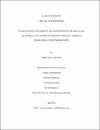Investigating adaptability of stadium precincts post Qatar 2022 world cup: toward an adaptive strategy through public-private partnership (ppp)
الملخص
Mega Sporting Events have become a way of transforming cities around the world. However, the sustainability of these large-scale transformations is questioned. This thesis aims to investigate the adaptability of stadium precincts post-Qatar 2022 World Cup based on selected case studies from Al Rayyan municipality. The challenges of using large facilities such as iconic stadiums are worth investigating.
The thesis aims to find answers to the following questions: To what extent is Qatar 2022 World Cup stadiums is adaptive to its precincts? What impacts the adaptability of Qatar 2022 World Cup stadiums? And How an adaptive strategy through public-private partnership can take place for Post 2022 World Cup?
A selection of case studies from Qatar includes Khalifa International Stadium, Qatar Foundation and Al Rayyan Stadiums are examined to answer the research questions. The thesis is based on qualitative case study research with three data collection and analysis tools. The tools used are site assessment (observations), expert interviews, and secondary data that include feedback from Al Rayyan residents toward Al Rayyan stadiums and precincts. The data is analyzed in the light of New Urbanism and the thesis conceptual framework to examine impact factors, opportunities and challenges for adaptability after a mega sporting event.
The research findings show that Qatar 2022 stadiums precincts can be very adaptable but can also face many challenges. Challenges include land use regulations, walkability, lack of unified urban design code, lack of housing options, and low building densities. Most of the challenges are beyond the scope of the stadiums’ owners. The extent of Qatar 2022 stadium adaptability to its precincts is promising, especially for stadiums that are within an existing urban development.in addition, factors impacting the stadiums adaptability included the stadium location, the design process and stakeholder’s involvement. However, stakeholder’s involvement also impacted the selection of the stadium location and the design process which emphasize the significance of a public-private partnership.
DOI/handle
http://hdl.handle.net/10576/5287المجموعات
- التخطيط العمراني والتصميم [44 items ]
- أبحاث كأس العالم 2022 [135 items ]


